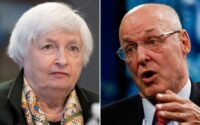US adds 272,000 new jobs in May — stoking migrant controversy
The American labor market continues to show surprising strength — and the latest numbers are sparking fresh controversy over the role of immigration.
The US economy added a whopping 272,000 jobs last month — far more than the 180,000 jobs that economists had expected — and some commentators say the continued influx of migrants over the US-Mexico border is a key reason for the upside.
“There’s an immigration piece to this,” CNBC’s senior economics reporter Steve Liesman said on Friday morning after the numbers were released.
“There are bodies available, and there is work for them to do,” Liesman said. “Whether or not they’re here legally or not is a different story.”
The Labor Department’s data for May showed that while the number of native-born workers in the US dropped by 300,000 versus a year ago to 130.4 million, the number of foreign-born workers rose by 637,000 from last year to 30.9 million.
News of the robust hiring sent stocks tumbling early Friday trades as it makes it less likely that the Federal Reserve will slash interest rates anytime soon. In addition to the blowout payroll numbers, wages rose an unexpectedly strong 4.1%.
In April, Fed Chair Jerome Powell said an upside of increased immigration has enabled the US economy to add more jobs without triggering a big spike in wages, and thereby inflation.
On Friday, however, pro-Trump superPAC Maga Inc. said the Labor Department’s latest employment report “paints a dire picture for the American economy” where “immigrants win while native-born Americans lose.”
Labor Department data released Friday also showed that the unemployment rate for foreign-born workers was 3.4% versus 3.8% for native-born workers. The foreign-born labor participation rate was also more favorable at 66.2% versus 61.6% for native-born workers.
Further complicating the economic picture on Friday, the unemployment rate edged up to 4%, from 3.9%. That ended a 27-month streak of unemployment below 4%, the Labor Department said — matching the longest such run since the late1960s.
Financial markets slashed the odds of a September rate cut, reducing the probability to about 53% from about 70% before the report, based on rate futures contracts. Traders now see roughly an even chance of two rate cuts by the end of 2024, versus about a 68% chance seen before the report.
“So much for slowing. The headline payrolls number is eye popping…. The Fed will take this to mean that they can still focus squarely on inflation without worrying much about growth,” said Brian Jacobsen, chief economist at Annex Wealth Management.
The healthcare sector added 68,000 jobs, continuing to lead employment gains as companies seek to boost staffing levels after losing workers during the pandemic.
Government payrolls increased by 43,000 positions. Employment in the leisure and hospitality sector rose by 42,000 jobs, with slightly more than half that total coming from employment in food services and drinking places.
Economists had forecast that the report would show that employers added 180,000 jobs in May, about the same as the 175,000 for April.
A key reason why the economy is still producing solid net job growth is that layoffs remain at historic lows.
Just 1.5 million people lost jobs in April. That’s the lowest monthly figure on record — outside of the peak pandemic period — in data going back 24 years.
After struggling to fill jobs for several years, most employers are reluctant to lay off workers.
Before the jobs report was released on Friday, tentative signs had emerged that the US economy was cooling in a way that would be welcomed by the Federal Reserve’s inflation fighters: Companies were posting fewer available jobs, consumer spending has slipped and wage growth, while still healthy, is gradually slowing.
Those trends marked a contrast from the start of the year, when hiring was robust and Americans were still spending at a solid clip — factors that may have also helped keep inflation stickier than the Fed wanted.
It appeared that the economy was no longer accelerating, which prompted economists and financial markets to worry about the opposite scenario: What if the economy weakens more than is needed to cool inflation? Could it eventually turn into a recession?
The unemployment rate was expected to have remained at 3.9%. Prior to May, the unemployment rate was below 4% for 27 consecutive months.
ADP released its own data for May, which showed that employers — excluding government agencies — added 152,000 jobs last month.
Steady increases in the number of people with jobs provides support for consumer spending, the primary driver of the economy.
Frank Fiorille, vice president of compliance and data analytics at Paychex, a payroll provider for small businesses, said that hiring actually accelerated among their clients last month.
“That sort of mom-and-pop, Main Street small business — we’re hearing still pretty positive things,” Fiorille said.
Fed officials will be scrutinizing Friday’s data on job growth and pay gains as they consider their next steps on interest rates, in particular when to begin cutting their benchmark rate.
In its fight against inflation, the central bank raised its key rate 11 times beginning in March 2022 to its current 22-year peak.
When the policymakers meet next week, they are poised to leave their benchmark rate unchanged but will update their economic projections, and Chair Jerome Powell will hold a news conference.
When the Fed began aggressively raising rates, most economists expected the resulting jump in borrowing costs to cause a recession and drive unemployment to painfully high levels.
Yet the job market has proved more durable than almost anyone had predicted.
Even so, Americans remain generally frustrated by high prices, a continuing source of discontent that could imperil President Joe Biden’s re-election bid.
Growing signs suggest that the job market is settling back to something close to a pre-pandemic normal.
The number of open jobs fell sharply in April for a second straight month, the government reported Tuesday, to the lowest level in three years. Still, openings remain well above pre-pandemic levels.
And the number of Americans who are quitting their jobs has also fallen back to pre-pandemic levels, a sharp shift from two years ago, when quits soared to record highs in the economic recovery from the pandemic.
Workers typically quit when they have — or think they can find — a new, often higher-paying job, so the slowdown in quits has helped cool wage growth.
Milder pay increases can help slow inflation because companies typically pass on their higher labor costs to their customers by raising prices.
With Post Wires


